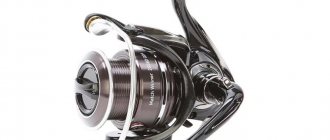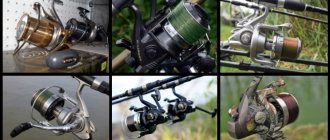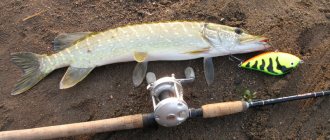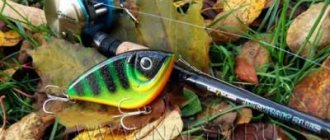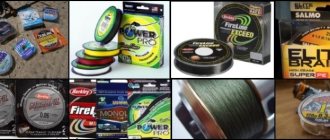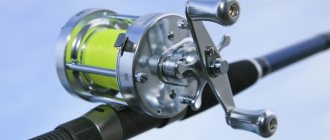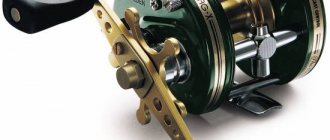When fishing with such an interesting and catchy tackle as an ultralight spinning rod, choosing the right reel is of great importance.
When choosing, take into account such characteristics as its type, weight and size, location and fineness of adjustment of the clutch, gear ratio, laying of the fishing line (cord), location and number of bearings, quality and size of the spool. In addition, the ease of use of the tackle is influenced by the height of the leg that attaches the reel to the rod, the shape and material of the handle.
Type
When fishing with ultralight tackle, two types of spinning reels are used:
- multiplier;
- inertialess.
Multiplier reels - sensitive, reliable and easy to use - are used in ultralight quite rarely due to the high cost of their models.
For this reason, when fishing with ultra-light baits, most anglers - from beginners to professionals and athletes - use spinning reels ("meat grinders").
Choosing a reel for light spinning
A light reel is the most important element in fishing. You can choose the most elegant fishing rod, but if you make a mistake with the reel, you can put an end to successful fishing.
Reels for spinning rods have undergone various changes for a long time, but now 3 of their main types are qualified, and it seems that no other designs are in sight. Reels for light fishing can be of the following types:
- inertial;
- inertialess;
- cartoon
Each of them has its own pros and cons, but it should be noted that all of these gear, with a certain skill of the fisherman, can be used well when working with light blanks.
Inertia coil
The good old inertia has long been the basis of spinning fishing. It is undeserved to forget her even now. This type of gear has its undeniable advantages:
- simplicity and reliability of design;
- durability;
- direct contact with the fishing rod without additional mechanisms;
- responsiveness to any actions of the fisherman;
- low price.
When fishing with light spinning rods, such reels are very convenient for shore fishing . However, they have their own distinct disadvantages:
- frequent formation of “beards”;
- difficulty in long casts;
- large amplitude swing when casting; this makes spin fishing impossible on shores with large vegetation.
Despite this, it should be noted that inertial reels are still very popular in light tackle fishing - no serious skills are required here, but the simplicity of the equipment makes such fishing accessible to any age.
“Seliger” is especially popular among domestic fishermen - its body is made of plastic (only the spool is aluminum), so the reel is light. , “Stinger” is suitable for light - also plastic models.
Spinning reel

These types of reels are believed to be the most in demand. Their undoubted advantages include:
- a certain ease of fishing;
- absence of frequent “beards”;
- multifunctionality; This tackle is well suited for both light fishing and, for example, trolling.
Many fishermen consider this reel to be universal , especially after the invention of the so-called endless screw, which allows you to lay the line crosswise . But such gear also has its disadvantages:
- sufficient design complexity;
- difficulties during repairs;
- reduced power; during light fishing this is not so noticeable, but it is still a disadvantage.
Expert opinion
Knipovich Nikolai Mikhailovich
Zoologist, hydrobiologist. I am interested in fishing at a professional level.
Attention! Often budget types of spinning reels lose their mobility when in contact with water. When purchasing, you need to pay attention to the security of the spool.
It is interesting that a reel for a light spinning rod of this type, for example, is considered the main one in Scandinavian countries.
Multiplier reel
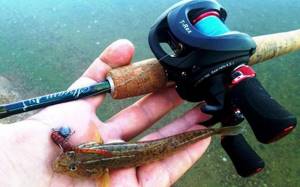
Initially, it was created for power fishing, but there are amateurs who cannot refuse the multiplier even during light fishing. So-called low-profile coils of this type were created especially for them; they are also called soap dishes . Several well-known manufacturers began to produce them: Daiwa, Shimano, Abu Garcia, Ryobi - these are the most worthy models.
Weight and balance
In light and sensitive ultralight gear, it is very important not to disturb its balance and sensitivity. To do this, choose coils weighing no more than 220 grams . The balance of the tackle is checked as follows:
- The coil is installed in a clamp (holder) on the handle of the form and securely fixed.
- The index finger of the right hand is placed under the front of the reel foot, clamped in the reel seat.
- The form is carefully lifted on the finger, insuring it with the left hand from falling and damage.
- If the blank is suspended almost parallel to the surface of the earth, the tackle is balanced and the reel is well selected for weight. If the blank tilts towards the butt of the handle or the tip of the blank, then the balance of the tackle is upset. In the first case, you need to choose a reel with less weight, in the second - with more.
Tips and tricks
The choice of reel depends on the spinning rod:
- The 500 level reel weighs up to 170 grams and is suitable for lighter spinning rods;
- Reel level 1000 and 1500: can be used on light spinning rods;
- Level 2000 is universal;
- The 3000 and 4000 level reels are designed for thicker spinning rods;
- Level 4500 is designed for catching large fish.
Thus, if the spinning rod is light, you should not choose a strong reel. This principle can be seen in this example: a spinning rod, the length of which is 3 m, is equipped with a level 2500 reel.
Before choosing a spinning rod, you should pay attention to the location of the reservoir and fishing gear. This is due to the fact that a certain type of fish has its own specific fishing habits. For example, trout moves quickly and just under the surface of the water, while catfish are slower and move along the bottom. It is in connection with these characteristics that the choice is made.
Size
For ultralight fishing, reels with the following line capacity (size) are used:
- 1000;
- 1500;
- 2000.
At the same time, reels with a line capacity of 1000-1500 are used when fishing with very thin (0.04-0.06 mm) braided cords using nanojig blanks with a test weight of 0.5 to 5 grams.
Reels size 2000 are used in fishing with monofilaments with a cross-section of 0.12-0.16 mm and braided cords with a thickness of 0.08-0.1 mm.
Reels of size 2500 and above are already used in fishing with heavier gear and bait.
Using them in ultralight fishing unreasonably makes the gear heavier and makes fishing uncomfortable. On a note! The size (line capacity) of the reel is deciphered as follows: size “2000” means that the spool holds 100 meters of monofilament (cord) with a cross-section of 0.20 mm.
Ultralight coil size
The size of the reel is determined by the capacity of the spool, and what fishing line and how much we can wind is indicated on the spool itself. As a rule, the size of the line is indicated by the breaking load in lb (pounds), and the quantity is indicated in meters, sometimes in yds (yards, 1 yard = 914.4 mm).
An interesting feature: relatively recently, it has become fashionable for Shimano and Daiwa to combine previously seemingly incompatible things - on the mechanism that comes next in size, leave the spool from the previous one, i.e. reduced in relation to the standard one. The result is a reel with a spool of, say, size 1500 and a reel mechanism of size 2000. A completely justified solution, because By slightly increasing the mass of the coil, one achieves an increase in its power characteristics. But is this really what we need in ultralight?
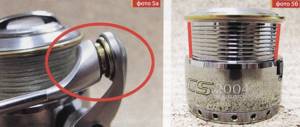
However, such reels are designated by Shimano as “C” (compact), and by Daiwa as “R” (reduce). Although the designations seem to be different, both words are translated from English as “shortened”.
In the designation of spools with a reduced line capacity and, accordingly, an increased core diameter (and they are very necessary for ultralight, since we use thin lines and cords - and it is advisable not to reel in the backing, which inevitably deforms the main line), the competitors also differ. Shimano uses the index "S" (shallow - small). But Daiwa simply indicates at the end of the “small” spool number the breaking load of the fishing line, which is placed on the spool in exactly one hundred meters. For example, in the marking for size 2004 (photo 1), the last number says that 100 m of fishing line with a breaking load of 4 lb can be wound here; the diameter of a monofilament line with such a breaking load is usually from 0.16 to 0.17 mm (photo 2). And a standard size 2000 spool of a reel of the same model fits 100 m of fishing line with a diameter of 0.28 mm.
Not so long ago, markings appeared on spools (though not on all of them, of course) (photo 3) for multi-fiber fishing lines (PE), and even for fluorocarbon (FLUORO). By the way, when winding, it is worth considering that the indicated numbers are for a completely filled bobbin, flush with the collar.
If earlier the quality of a reel could be assessed by looking at the spool: always metal plus with a collar coated with titanium nitride - these were the main indicators of the “steepness” of the reel (I remember that if the reel did not have these options, its class was downgraded to at least “amateur” ), then at the moment this detail is not attracting attention.
As time passed, the approach changed. Ultralight reels became lighter and lighter. For example, Daiwa has been using polycarbonate as a material for making spools for a long time. In terms of strength, spools made of this material are not inferior to metal ones, but they are so much lighter that it turned out to be practically a panacea for the required reduction in the weight of the ultralight reel. By the way, this is far from the same plastic that was used, and is still used in cheap reels - the price of polycarbonate spools is even higher than metal ones.
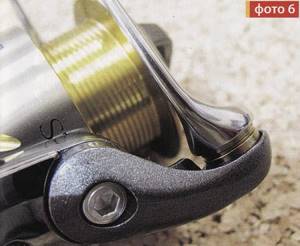
Now - about the specific sizes of coils for ultralight. Size 750 Shimano has recently become popular among ultralight spinning riders. However, this does not always mean that the line capacity of such a reel will be less than that of a “thousander”, especially if there is an “S” index on the spool. But we will be primarily interested in sizes from 1000 to 2000 for Shimano and from 1003 to 2004 for Daiwa. There are also sizes that, at first glance, are somewhat large for ultralight: I’m talking about models of sizes 2500 and 2506. However, due to the fact that they use lightweight composite materials, such reels are also used in ultralight, although somewhat limited and on fairly “weighty” spinning rods.
I consider Daiwa’s 2004 to be a universal size, suitable for almost all ultralight spinning rods; for Shimano it will be size 2000 with a spool of reduced line capacity.
I try to strictly adhere to the principle of “the smallest reel for the lightest spinning rod.” That’s why I use “thousanders” with very light ultralight spinning rods, where the upper limit of the test is no more than 1/8 ounce, i.e. 3.5 gr.
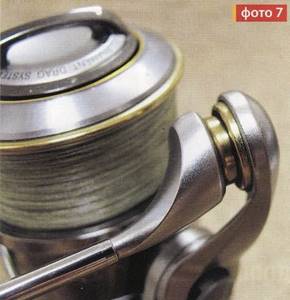
Here in front of you is a certain “base”, which I took as a basis at one time. With the advent of new, lighter reels, only the numbers changed, but I left the principle of forming ultralight tackle, and, in particular, selecting a reel by size and weight:
reel size 1000 or 1003 (weight up to 170 g) – ultralight spinning dough up to 3.5 g (1/8 oz);
reel size 2000 or 2004 (weight up to 190 g) - ultralight spinning dough up to 5 g (3/16 oz).
Well, an intermediate size between ultralight and light:
reel size 2500 or 2506 (weight up to 200 - 210 g) - ultralight spinning dough up to 6 - 7 g (1/4 oz).
And also about spools of increased diameter. It should not be simplified to think that such a spool - say, with the ABS (Anti-Backlash System) system from Daiwa - is a guarantee of ultra-long casting. It seems clear that a larger diameter means fewer turns of the fishing line per unit of its total length, which leads to the fact that the fishing line spins less, provides less resistance when casting - and the cast is longer. But, naturally, we cannot indefinitely increase the diameter of the spool. You need a clear understanding that the correct choice of reel size for an ultralight is an interconnected set of conditions, where the diameter of the fishing line and the size of the bait, in addition to the length of the ultralight spinning rod, its test and action, are also equally important components.
Clutch type
In ultralight fishing, reels with a front-mounted friction brake are used. The friction clutch must be reliable and have sufficiently fine adjustment.
The clutch adjustment should rotate comfortably and easily, and have a special gasket that prevents water from penetrating into the bobbin space.
Important! The friction brake should ensure uniform line release when the fish jerks or pulls. Therefore, the clutch, configured for a certain force of line retraction, should rotate evenly without any, even the most insignificant, braking or jamming.
Main characteristics of an ultralight reel
The complete set has a list of particularly important characteristics, the totality of which determines the quality:
- Size . The capacity of the spools determines the size. On the surface of the spool, the number of turns of the fishing line and its main parameters are indicated (breaking load in pounds, and quantity in meters).
- Weight . One of the most important characteristics. A lightweight reel is considered the best option, as a counterweight allows you to balance the spinning rod. The small mass practically eliminates interaction on the dynamic component of the spinning rod. This is what ensures increased comfort in the process of catching fish.
- Balls and rollers .
The number of balls is not considered the main point, since the operation of the tackle with 1 or 12 bearings does not change significantly. The function of the bearing is to increase the operating period. Since there is no load when catching fish, and consequently, mechanical damage is minimal. The work process does not depend on the number of balls, but on the kinematic plan and the quality of the constituent components. - Friction brake . An important option for an ultralight spinning rod is a friction brake, which relieves the load on the tackle and protects it from damage.
- The principle of spool feeding . There are 2 options: Worm. The best option. Lapping suppression ensures minimal stress.
- C-shaped groove.
- 5 – rotor speed;
1 – value of handle revolutions.
It follows from this that the speed of the coil depends on the speed of the rotor. The universal speed is the rotor speed in the range from 5 to 5.5. If the rpm value is less than 5, an ultralight class spinning rod is considered as a power option.
The ideal subordinate number is considered to be the lowest value, for example, 4.7:1 and 4.8:1. This feature is suitable for a fishing beginner. More experienced anglers choose indicators such as 5:1 or 5.1:1. These indicators produce high and low wiring, which are used when fishing.
The gear ratio depends on the weight of the bait, the type of fish and the location of the reservoir. A high subordinate number is used if the fishing process takes place on a lake or river, to catch pike (slow retrieve) or asp (fast retrieve).
- Maximum braking force of the reel mechanism;
Sticking of the clutch mechanism.
The braking force depends on the load on the line and the test of the rod. The ultralight coil is used for 2–4 kg. If the indicator is exceeded, the spool rotates and releases the line. Therefore, a critical load on the tackle is not allowed.
There is a delay before the clutch engages. If the coil is of poor quality, there is a poor reaction to the jerk and a delay in the operation of the mechanism. In this case, the line breaks and the fish escapes. If the jerk is strong, the reel and rod may break. A higher quality brand will operate smoothly and instantly .
Friction brake is divided into two types:
- Frontal;
- Rear.
The front friction brake is considered more practical than the rear one.
When setting up a friction brake, you should pay attention to how the mechanism operates. More precise adjustment occurs while fishing, taking into account its weight and fishing location.
In this regard, we can conclude that the main indicators are the compatibility of the fishing line and the roller, the weight of the bait, the adjusted braking mechanism, and the balancing of the reel.
Line laying
Since ultralight fishing uses very thin cords and monofilaments, their placement with a reel must be of the highest quality. There should be no dips or obliquely wound turns. The fishing line or cord must be wound perfectly, “turn to turn.”
Poor laying of the cord or fishing line with a reel can lead to the fact that when winding, the upper turns will fall under the lower ones and the next time you cast, the loops will be dropped and a “beard” will form. It will be almost impossible to untangle a tangled, wet thin cord or monofilament line - the knots on it are very quickly tightened, untying which will take a very long time and injure the cord (when untying, you will have to use a thin needle or the point of a hook).
The uniformity and quality of laying is regulated using a mechanism such as an “endless screw”, as well as by placing additional washers under the spool.
On a note. When purchasing a reel, the quality of its line laying can be visually assessed by how evenly, without braking, jamming and obvious stops, the reel spool makes reciprocating movements.
Innova Ultralight 2004

A real hit of last season (photo 1) . The first batch of these reels arrived in the spring and were instantly swept off the shelves and warehouses. After this there came a long break while waiting for the second delivery, which was first scheduled for August, then for September. At the beginning of September, the “Efremovsky Chub” tournament (stage of the “Chub Plus” tournament) was planned - and five participants at once really hoped that they would receive their “Stingers” precisely for the tournament.
Surprisingly, this is what happened. The first reel from the new batch (which was on its way to the exhibition at the All-Russian Exhibition Center) “straight from the wheels”, from the St. Petersburg - Moscow train, fell into my hands on September 2 - and I immediately went with it to the Efremovsky Chub, and after it Several more reels were brought from the exhibition to the same tournament. There was no time to roll them out, the participants wrapped the cords around the Stingers and ran to registration. It must be said that when the “Stingers” gathered in the evening to exchange experiences - to express their opinions on the reels, and the conclusions were as follows: there are some shortcomings, but they can be eliminated, but in general I really liked the reel.
I often catch chub and other white predators with fairly large and stubborn cranks, which create powerful resistance when retrieving or holding it on a strong current of a riffle. Most often, such a load is disastrous for reels - and after several days of such fishing (even without taking into account the capture of large fish), noticeable backlashes, growling, and incorrect operation of the bow closing mechanism appear in the reel mechanisms. Such shortcomings also appeared after fishing with fairly expensive reels from Japan - their units are simply not designed for such loads.
Amazingly, the Innova Ultralight reel passed all these tests with honor. I will note the good traction for reeling stubborn baits and the excellent even laying of the cord on the spool. The reel was also tested in winter: we caught fish with it even in good frost (photo 2) - and all the components worked correctly and clearly. The handle of the reel is screwed into the main shaft of the transmission mechanism, which reduces backlash and increases reliability.
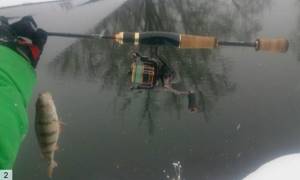
But it must be said honestly that some reels produced in 2021 had minor defects. For some reels, the cord got stuck in the line guide roller, and for some, the cord got stuck under the top of the spool. We were lucky, our batch of coils did not have these shortcomings, everything worked like a clock.
At the exhibition that took place at the end of February this year in Moscow at the All-Russian Exhibition Center, Mikhail Nikishatov answered questions from users about Innova. He said directly and clearly: “We know about the shortcomings; the new batch of Innova Ultralight 2004 reels, which will arrive in Russia in June, will not have these shortcomings. The owners of all reels sold last year, which is 1,500 customers, will be given improved units - a new spool and bail along with a line roller.”
To my question: “What is this magical attitude towards customers, which is not entirely typical for our country, like in a Mercedes or Volvo?” — Mikhail Sergeevich modestly answered: “We are trying to comply.” It's damn nice that there are such proper relationships between fishing companies and clients.
The Innova reel is the lightest among the competitors described in the review. Therefore, it can be successfully used both in ultralight fishing and in the next class - light (test for lures up to 14 g).
Characteristics of Innova Ultralight 2004:
- lightweight carbon ceramic body;
- Direct Drive system;
- turned handle;
- gear ratio 5.2:1;
- bearings 10+1;
- friction pull 3 kg;
- weight 175 g;
- spool capacity 0.14 mm – 140 m; 0.16 mm – 100 m; 0.18mm – 70 m.
Number and location of bearings
An inertia-free reel for ultralight fishing must have at least 4 bearings (3 ball and 1 roller) located:
- in the main pair mechanism - on the axes of rotation of the drive gear and driven worm gear;
- in the line laying mechanism - in the line laying roller;
- in the reverse stop mechanism there is an overrunning clutch.
More expensive and high-quality models are equipped with bearings in the friction brake mechanism and handle knob

Instant reverse stop on ultralight reels
Today, almost all more or less high-quality reel models, and not necessarily the flagships of the world market, have this design feature. The stopper mechanism prevents the rotor from turning in the opposite direction when hooking or at the final stage of retrieving, when it is necessary to take the fish with your free hand. The main thing is not to forget to turn on the switch key (lever). Well, for those who constantly forget, in some very modern models - for example, Daiwa Aegis 2004, Daiwa Ignis 2004 - this switch is missing altogether: the reverse stopper is always in the on position.
In general, it’s hardly worth saying that life is not sweet without an instant stopper, but everyone is already so accustomed to it that they take its presence in the ultralight reel for granted. Only on very cheap reels it is absent, and there the rotor stops with a noticeable rebound. And these are serious shock loads on the reel mechanism.
Spool
An ultralight reel must have a spool that meets the following requirements:
- spool material – aluminum or duralumin;
- profile – cone, reverse cone;
- diameter of the working part – 40-45mm.
In addition, the spool must have a wear-resistant edge coated with titanium nitride alloy, a soft and non-traumatic fishing line or braided cord, and a silicone clip. For fishing with monofilament, the reel package should include a graphite (plastic) spool along with a metal spool.
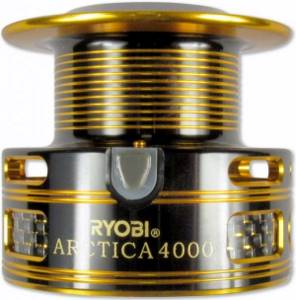
Okuma Inspira 2500S
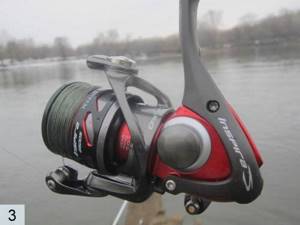
"Okuma" is one of the recognized monsters of reel manufacturing, both in terms of the number of products produced and in the countries where they have representative offices. The widest model range, huge sales volumes. This year, at the exhibition at the All-Russian Exhibition Center in Moscow, fishermen were treated to a pleasant novelty - a new Inspira 2500S reel with a shallow spool (photo 3) .
As they said at the company's stand, her fate was very difficult. The fact is that representatives of Okuma in Russia have long known that spinning anglers in our country really need a light reel with a small spool, which allows you to wind a thin cord without backing, which eliminates the cord being pressed inside the turns under heavy loads and eliminates such unpleasant moments, as the formation of a “beard” during subsequent casting.
It made no sense to make such a small spool for existing models - the part would have been produced when it went into production for almost the price of a new reel. But it was also unprofitable for Okume to produce a new reel for Russia - there were not enough required volumes. But when representatives of the Okuma head office made inquiries to other countries whether they needed such a reel, suddenly an unexpected answer came from Japan that in the Land of the Rising Sun such a reel would be in demand on the domestic market.
The issue was resolved - and now the new reel could be seen at exhibitions, and it was even available for sale. This reel is delivered to Russia in the same form and in the same box as to Japan.
Characteristics of Okuma Inspira 2500S:
- gear ratio 5:1;
- bearings 8+1;
- friction pull 3 kg;
- weight 210 g;
- spool capacity: monofilament 4 lb -130 m, 6 lb – 85 m; PE #0.6 – 195 m; #0.8 – 150 m.
Smooth ride
The quality of play of the bait and the uniformity of winding of the fishing line on the spool are influenced by such characteristics of a spinning inertia-free reel as the smoothness of its movement. It depends on the quality and quantity of bearings, the reliability of the main pair mechanism, and the presence of lubricant in it:
- So, if the reel is equipped with reliable ball bearings, has a high-quality and well-lubricated transmission mechanism, its movement will be smooth and easy, thanks to which the angler will be able to perform different speed retrieves and will be able to feel even the weakest poke or grip of a predator in time.
- A reel with low-quality and short-lived bearings, a main pair mechanism, or with poor or insufficient lubrication will have difficulty moving, often with slowdowns and jamming . This will all affect the quality of the wiring, the laying of the fishing line and, subsequently, the comfort and result of fishing.
Advantages and disadvantages of using ultralight
An ultralight reel has negative and positive qualities.
Positive characteristics include:
- Rod length from 1.58 to 2.35 m;
- Light metal alloys are used in manufacturing;
- The weight of the catch varies from 0.5 to 4.5 kg;
- Has a soft and smooth ride;
- Balanced and protects against vibrations;
- The diameter of the fishing line ranges from 0.12 to 0.18 mm;
- Ensures uniform return of the spool, due to which the fishing line is distributed over the surface without failure;
- The line roller helps with line twisting, preventing it from twisting;
- Sensitive friction brake that responds instantly to jerks;
- Fine adjustment of the clutch.
Negative characteristics include:
- Excessive load disables the transmission mechanism and disrupts its operation;
- Slow reel speed at low gear ratio;
- Fewer bearings, which affects the reliability of the reel;
- The fluoroplastic bushing ensures sliding only with minimal load;
- Specific terms of use;
- Difficult to use.
It is necessary to pay attention to the fact that every year manufacturers make improvements in the production of ultralight spinning rods. This applies to both the production of parts and the material used.
Line laying roller and bow
The line laying mechanism (shackle and roller) of an ultralight meat grinder must have the following characteristics:
- The bow must be made of strong, but at the same time flexible stainless wire - this is necessary so that when the form is hit or dropped, the bow bends and does not break.
- The roller of the line laying mechanism must be equipped with a high-quality ball bearing. The working surface of the roller must be coated with titanium nitride alloy.
- The opening and latching of the line handler's bow must be ensured by a reliable mechanism that prevents spontaneous closing of the bow during casting. This parameter is checked when purchasing a reel in a store: to do this, by opening the line handle, the reel is shaken sharply several times, simulating a sharp cast. In high-quality models, the bail will not close even with very strong shaking; in low-quality models, it will snap off at the first sharp cast, leading in a real situation to the “shooting” of the bait or damage to the blank.

Reel size for light spinning rod
Coil diameter
In this case, you need to follow the main principle - a light spinning reel should be selected for a specific fishing rod. Here the weight and size of this gear must be carefully adjusted. If the reel is too light, the blank will begin to “peck” when casting; if the weight turns out to be too much, the rod will begin to fall back .
It is believed that budget-type light fishing reels tend to be short-lived. More expensive models are made of ultra-light materials and are more reliable, but not every fisherman can afford this.
One way or another, when going fishing with light tackle, you first need to take into account the size of the spool . The traditional size in these options is 1000 – 2000 – 2500; the size depends not only on the rod, but also on the weight of the bait that you intend to use. Moreover, the diameter of 2500 is supposed to be used only for large chub or pike; in other cases, a smaller diameter is quite suitable.
The most popular is the two-thousander, but you don’t need to buy cheap, little-known models, they are. usually. are overweight or their coil diameter is indicated with deviations.
When using inertial coils, you can use a larger diameter, however, if the weight of the coil does not increase significantly and its main body is plastic.
Bobbin size

An immutable law is observed here - the spool for light fishing should not be deep so as not to make casting difficult. Let's say, a light Daiwa reel, with a size of 2004, winds up a line of up to 100 m with a cross-section of 0.17, and a standard one - one and a half times more. But the casting range increases and line wear is reduced.
When buying foreign reels, you should remember that on some of them the marking C 3000 indicates a certain brand of spool, and their reel size is 2500, which, of course, is suitable for light.
Reel handle
The ease of use of the reel is influenced by such characteristics of the reel as the strength of the handle, its angle relative to the axis of rotation of the drive gear, the size and size of the knob, and the presence of a bearing or bushing inside it. The most convenient reel should have the following indicators of these characteristics:
- The angle between the axis of rotation of the handle and the part extending from it should be more than 90 0 - thanks to this, when rotating the handle, the angler does not cling to the wire handle with his fingers.
- The handle should be made of durable and lightweight alloy or graphite.
- For convenience, the handle should be equipped with a tip, by which the angler will rotate it - a knob. The knob should be made of porous soft rubber, light wood and equipped with a small ball bearing.
Rating of the top 3 budget ultralight reels (cost up to 5,000 rubles)
Ryobi Ecusima 1000 VI
Characteristics:
- Spool line capacity: 145 meters of 0.205 mm monofilament.
- Weight: 262 gr.
- Number of bearings: 5 pcs. (4 ball + 1 roller).
- Clutch location: Front.
- Maximum load on the clutch: 2.5 kg.
- Gear ratio: 5.1:1.
- Number and material of spools: 2 spools (plastic and metal).
Advantages:
- smooth ride;
- friction clutch with fine tuning;
- durable metal case;
- good line laying.
Flaws:
- noticeable weight for ultralight gear;
- Repositioning the handle requires the use of a special tool.
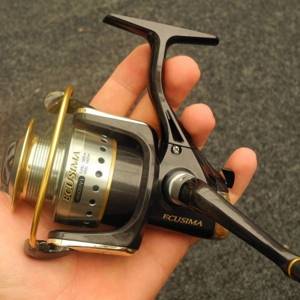
Daiwa REVROS E 1500 A
Characteristics:
- Spool line capacity: 140 meters of line with a cross section of 0.2 mm.
- Weight: 225 gr.
- Number of bearings: 4 pcs. (3 ball and 1 roller).
- Clutch location: Front.
- Maximum load on the clutch: 2 kg.
- Gear ratio: 4.8:1.
- Number and material of spools: The package includes one metal spool, no graphite spare spool.
Advantages:
- light weight, high-quality laying of the cord (line);
- reliable and finely adjustable friction clutch.
Flaws:
- a large number of Chinese and Vietnamese fakes.
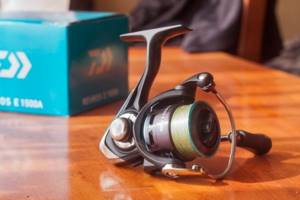
Shimno Catana 2000SFB
Characteristics:
- Spool line capacity: 270 meters of 0.20 mm monofilament.
- Weight: 290 gr.
- Number of bearings: 3 pcs. (2 ball + 1 roller).
- Clutch location: Front.
- Maximum load on the clutch: 3 kg.
- Gear ratio: 5.2:1.
- Number and material of spools: 2 spools (graphite and metal);
Advantages:
- easy and smooth running;
- large bobbin capacity;
- durable and reliable body.
Flaws:
- heavy weight;
- small number of bearings.
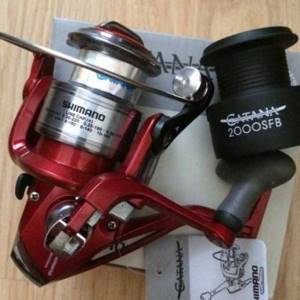
Rating of the best reels for ultralight
Daiwa Infinity-X 5500BR
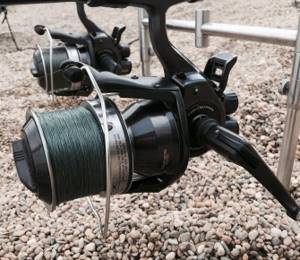
This inertia-free option receives only positive reviews from those anglers who fish for carp. A distinctive feature here will be the casting range and a high level of correct line winding. The spool in this case consists of titanium, which is covered with a layer of ceramic. This allows for minimal impact from other elements. If we talk about bearings, there are 5 of them. This allows you to quickly remove the device from the water. The weight is almost 800 g and the reel is ranked among the best for carp fishing.
Daiwa Infinity-X 5500BR
Video analysis of the coil:

If we talk about the features of this reel, here we can highlight a control system for fishing line and spool vibration at 2 speeds. This allows for smooth movement and uniform winding. It is included in popular models thanks to the reverse locking system. There are three bearings, two of which are ball bearings and one is roller bearing. The reel weighs 260 g, which is supported by a stylish design that attracts the attention of many anglers. If we also talk about the reel, then it is included in the rating of quality devices also for picker.
Shimano Catana 2500 FC
Advantages:
- Smooth ride;
- Beautiful appearance;
- Quality elements.
Flaws:
- Small number of bearings.
Ryobi ECUSIMA 3000
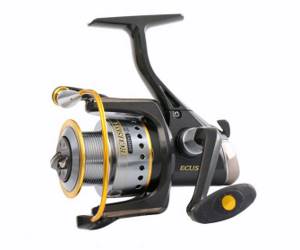
If you are wondering which company is better to purchase a reel, then this option will be one of the answers to your question. This powerful and durable design has a minimal weight, which is slightly more than 300 g. The mechanism is balanced, which allows the element to compete with other elite rivals. A total of 5 bearings are built in, 4 of which are ball bearings. The body is entirely made of metal alloy, and the durability of the spool is achieved by sputtering titanium. The fishing line adapts very well to high loads, and this model is also included in the most inexpensive accessories.
Ryobi ECUSIMA 3000
Video review of the reel:

The best manufacturers have made this reel using advanced technologies and good new materials. This includes protected bearings, the number of which is 5 pieces, as well as a high-quality spool and rotor. The design is equipped with rear adjustment, which allows the tool to operate stably when fishing, as well as increase the overall resource. The weight here is about 200 g, and a protective case is also included. This is one of the best devices that has the necessary functionality for a good ultralight.
Shimano Ultegra-12 1000
Advantages:
- Good line winding;
- Smooth ride;
- Brake system in reverse.
Flaws:
- Quality annual maintenance is required.
Daiwa REVROS E 1500 A
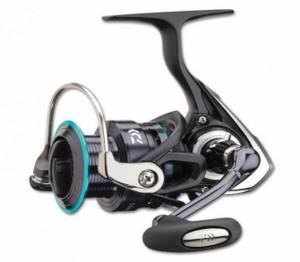
If you are wondering which reel you need, then this option will be the next contender for your choice. The characteristics here are simply impeccable for such a price. The manufacturer has tried and improved the series with the latest developments, which include three ball and one roller bearings of excellent quality. The spool is universal, in the manufacture of which high-quality material was used. Thanks to the large diameter of this element, better line winding speed and clutch operation are ensured. The weight is 225 grams, and therefore the reel is included in ultra-light baits.
Daiwa REVROS E 1500 A
Video review of the reel:
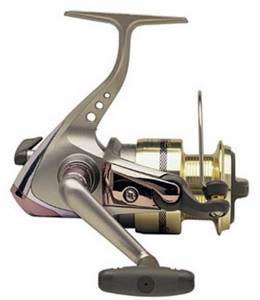
This reel opens up budget options. It is relatively cheap, but do not think that there is no quality of materials and workmanship. The design is made of a metal body and has a well-designed spool. The last element consists of aluminum, which allows the mechanism to be used for a long time. The number of bearings is present in the size of 4 pieces, and there is also an anti-twist line.
Daiwa Caprice 1500
Advantages:
- Built-in lock that prevents the line from dropping when casting;
- Metal structure;
- Built-in line anti-twist;
- Price.
Flaws:
- Number of bearings: 4 pieces.
Daiwa 17 AEGIS

The rating continues with a new product from China, which is already beginning to conquer the whole world. This part is included in inertia-free lightweight models that are perfect for ultralight fishing. If we compare this device with expensive elements, the installation has a smooth and easy operation, and the friction mechanism allows you to precisely adjust many functions. Here you can work even with the smallest diameter cords and fishing lines, in which the work will be delicate and with increased precision. This number of factors allows us to place the reel among the best options in its price range. The number of bearings here is 8 pieces, 7 of which are ball bearings. The case material is metal, which is equipped with a stylish design.
Daiwa 17 AEGIS
About this and other coils in the series - in the video:

The rating is continued by a Japanese company, which is known to many fishermen for its high-quality reels. And this applies not only to expensive models, but also to budget ones too. How to choose the right option from this company? This particular model is a budget representative that maintains high quality at a low price. The line is represented by models from 200 to 350 g, as well as a built-in housing made of high-strength elements. The reel is equipped with 2 bearings, one of which is roller and the second is shielded from steel.
The rotor has the ability to independently move in the opposite direction, and there is also a built-in spool, which was patented by the same manufacturing company. A good design allows you to combine technical characteristics that reduce friction with the fishing line and increase the casting of the bait. The line roller design reduces possible line tipping, which avoids the creation of loops.
Shimano Sienna 1000 FE
Advantages:
- Low price;
- Light weight;
- Good appearance, which is complemented by technical advantages.
Flaws:
- Small number of bearings;
- There is no spare spool included.
SALMO DIAMOND TROLL 2
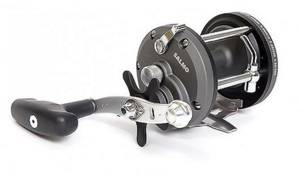
Your gear will be completely complete with this reel, which is designed for both ultralight and trolling. The graphite body combines well with steel ring elements and can withstand heavy fishing loads. It contains 5 bearings, which are equipped with a high-quality brake system. The weight of the model is slightly more than 500 grams.
SALMO DIAMOND TROLL 2
Video review of the device:

If you don't know how to choose the right option, then this reel will be the solution to your problem. It is designed for different types of fishing with bait. The body is a frame structure made of aluminum - a durable and lightweight material. The weight is only 310 g, and the mechanism is equipped with high-quality 4 bearings.
Abu Garcia Ambassadeur SX-6600
Advantages:
- Control of the entire biting process;
- The coating has wear-resistant characteristics, which allows you to use the reel for a long time and without any restrictions;
- Good maneuverability.
Flaws:
- There are restrictions on the weight of the bait used;
- High price.
Top 3 rating from the expensive segment of ultralight reels (cost over 5,000 rubles)
Shimano Ultegra-12 1000
Characteristics:
- Spool capacity: 240 meters of PE cord;
- Weight: 180 gr.
- Number of bearings: 6 pcs. (5 ball + 1 roller).
- Clutch location: Front.
- Maximum load on the clutch: 3 kg.
- Gear ratio: 5.0:1.
- Number and material of spools: 1 metal spool.
Advantages:
- light weight;
- lightweight rotor;
- high-quality and reliable bearings;
- stylish and beautiful appearance.
Flaws:
- the need for annual maintenance;
- very high price.
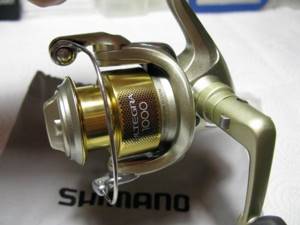
Shimano Exage 1000 FD
Characteristics:
- Spool line capacity: 140 meters of 0.20 mm monofilament.
- Weight: 200 gr.
- Number of bearings: 5 pcs. (4 ball + 1 roller).
- Clutch location: Front.
- Maximum load on the clutch: 2 kg.
- Gear ratio: 5.0:1.
- Number and material of spools: 2 spools (graphite and aluminum).
Advantages:
- light weight;
- excellent laying of fishing line (cord);
- friction clutch with fine tuning;
- reinforced handle.
Flaws:
- not detected.

Shimano 17 Nasci 1000 (9100)
Characteristics:
- Spool line capacity: 90 meters of 0.25 mm monofilament.
- Weight: 215 gr.
- Number of bearings: 5 pcs. (4 ball + 1 roller).
- Clutch location: Front.
- Maximum load on the clutch: 3 kg.
- Gear ratio: 5.0:1.
- Number and material of spools: 1 metal spool.
Advantages:
- multi-stage clutch adjustment;
- smooth ride;
- ideal winding of fishing line (cord);
- reinforced handle;
- protection against moisture and dirt getting inside the case.
Flaws:
- not detected.
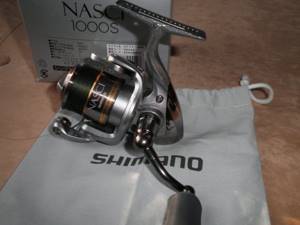
Top 5 expensive reels for ultralight
• Shimano 13 Nasci 1000S
: popular spinning reel, modernized in 2013. Excellently balanced tackle, suitable for long casts. Spool size – 1000, model weight – 215 g, gear ratio – 5.0:1.
• Daiwa Aegis 2004
: stylish spinning reel, made in red and black colors. The model is a graphite case equipped with an Air Rotor. This ensures smooth running and reliability of the entire mechanism. Weight - 195 g, power thrust - 2 kg, rpm ratio - 4.8:1.
• Abu Garcia Revo Premier 20
: combined reel, body made of metal alloy with carbon inserts. The spool is aluminum, complemented by perforation. Weight is 185 g, forest capacity is 0.25 mm/110 m, speed ratio is 6.2:1.
• Daiwa Certificate 10 1003
: Japanese ultralight reel equipped with a Magsealed system that protects the internal mechanism with ferromagnetic oil. Consists of ten bearings. Weight – 195 g, power load – 2 kg, gear ratio – 4.8:1.
• Shimano Twin Power C2000S
: a powerful reel for ultralight class rods with a maximum thrust of 3 kg. Equipped with the Coreprotect system, so it can be used in sea fishing. The Hagane Gear drive ensures stable operation of the entire internal mechanism. Weight – 193 g, speed ratio – 5.0:1.
Adviсe
To conclude the article, there are some useful tips on choosing and using ultralight reels:
- When purchasing a reel for a previously purchased fishing rod, experienced fishermen check the balancing of the gear by bringing the spinning rod with them . This technique will allow you to choose the most suitable reel for the form and avoid future trips to the store to replace a meat grinder that is not suitable for the weight;
- A large number of bearings (more than 10) is by no means a sign of a good reel. Very often, meat grinders with 4-5 high-quality bearings rotate softer and better than Chinese models, which have 2-3 times more low-quality and short-lived bearings;
- Check the fineness of adjustment of the friction brake as follows, loosen the brake by about 1/3, lower a small amount of cord (line) from the spool, close the line handle and, holding the cord, lift the reel 60-70 cm above the floor. With a high-quality and well-adjusted clutch, the reel will smoothly lower to the floor under its own weight. A poorly adjusted and poor-quality clutch is characterized by pauses and braking during lowering;
- In order to evenly and correctly wind the new cord (line) onto the spool, the reel with it is lowered into a container of water.;
- Even the highest quality reel is recommended to undergo annual maintenance : check the integrity and performance of the bearings, the main pair mechanism, the clutch, and possibly change the lubricant. You need to entrust this matter to professionals.
Reel weight for ultralight
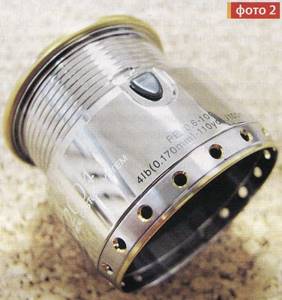
The weight of an ultralight reel is practically one of the most important parameters for an Ultralight. The lighter the ultralight reel, the better. Such lightness is not always in demand in other categories of spinning rods other than ultralight, because there, the reel often acts as a counterweight, balancing the spinning rod. In ultralight everything is different: taking into account the fact that our ultralight spinning rods are not distinguished by either increased power or, as a rule, “fastness”, the lighter the reel for ultralight, the better. The low weight of the reel has minimal impact on the dynamics of the tackle as a whole. This increases the overall comfort of fishing and the balance of the entire gear. And, as a result, general sensitivity. So you shouldn’t look for some mythical balance point in ultralight gear, as they try to do in heavier types of fishing. For an ultralight there is no such thing as a “very” or “too” light reel, but with a heavy reel you can “kill” the tackle in one or two ways!
In ultralight reels in the middle and higher price ranges, weight reduction is achieved through the introduction of parts from special materials into production, many of which (like carbon fiber for spinning rods) came to us from aerospace production.
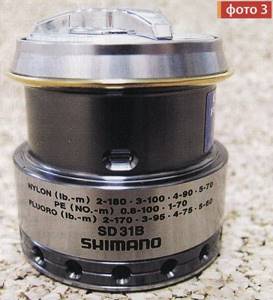
By the way, such materials themselves are quite expensive. Plus there are certain difficulties with their processing, and this, of course, requires special machines and a lot of additional costs. And the final price of a thousand or more US dollars for top models of ultralight reels has not confused or surprised anyone for a long time.
But ease of ease is different. After all, the lightness of cheap reels can be comparable to top-end ones, but in ultralight reel models in the low price range, by definition there is no talk of using high-quality materials, and all other parameters - such as smoothness, line processing, friction brake, etc. - are far from perfect. Plus a short service life.
I will not dwell in detail on the so-called “revolutionary materials and technologies”. I think many people are familiar with complex composite materials and titanium-magnesium alloys, which are already used in the production of reel housings. And heat-treated duralumin, which has very high mechanical strength, is used to make not only body parts, but even gears in the transmission mechanism, thereby achieving an even greater reduction in the weight of the ultralight reel. You can read in great detail about all the innovations on the specialized websites of the manufacturers themselves and on the websites of dealers. Well, both of them are lying a little, wishful thinking, where without it, you have to live somehow! Especially during a period of global crisis and a significant decrease in consumer demand. And advertising, as you know, is the engine of trade. But, all the same, the general vector of development of the coils can be traced quite easily.
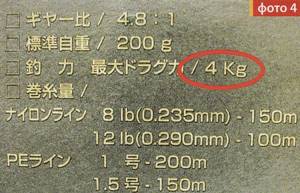
If we measure the weight of an ultralight coil that suits us with specific numbers, then the optimal weight parameter for an ultralight ranges from 160 to 200 grams. At first glance, the difference of 40 grams may seem insignificant at first glance. But, believe me, the more delicate our ultralight spinning rod is, both in test and in structure, the more sensitive it is to the weight of the reel. Don't discount the system either. Faster spinning rods seem a little more powerful than slower ones. Therefore, with “fast” ultralight spinning rods, a difference of 5 - 10 grams is unlikely to be noticeable, which cannot be said about “slow” ones - there you can already feel the difference. The situation is similar with the length of an ultralight spinning rod: all other things being equal, i.e. with a similar test and action, a longer spinning rod will feel a little softer.
